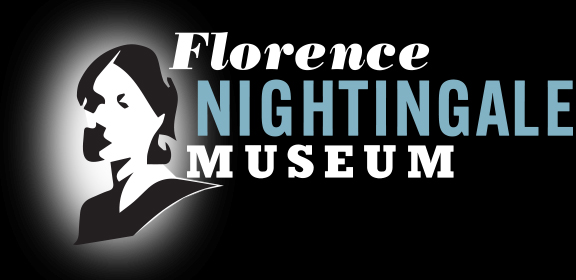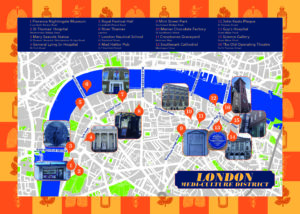A Self-Guided Health Walk Around London’s Medi-Culture District
Take a walk through medical history and modern wellbeing and explore the medicinal connections from the Florence Nightingale Museum to the Old Operating Theatre. Discover a monastic herb garden, 1950s exercise regimes, Victorian workplace risks, the founding of a children’s hospital, and the health benefits of chocolate and beer!
You can download the map or use the saved Google Map to guide you on your walk. You should keep this webpage open and use the tabs below to find out more about each stop as you walk. Alternatively, you can download a PDF with all the stop information.
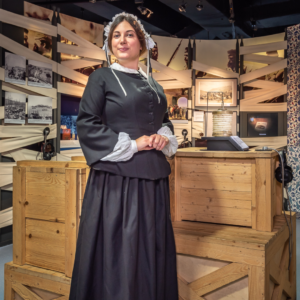 Celebrating the life and work of the best-known figure in British nursing history, Florence Nightingale, the museum showcases her life, time in the Crimean War, statistical work and work on health reforms. Items on display include the famous lamp she carried in Crimean War, her personal medicine chest, copies of her statistical charts and her pet owl, Athena.
Celebrating the life and work of the best-known figure in British nursing history, Florence Nightingale, the museum showcases her life, time in the Crimean War, statistical work and work on health reforms. Items on display include the famous lamp she carried in Crimean War, her personal medicine chest, copies of her statistical charts and her pet owl, Athena.
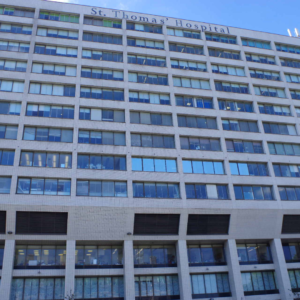 Founded in the 12th century, the hospital was originally based near London Bridge and moved here in 1871. Inside is a small exhibition on the history of St Thomas’ Hospital and a statue of Florence Nightingale. The hospital chapel has a bust of Florence Nightingale and a memorial to Sarah Wardroper, the first Superintendent of the Nightingale Training School for Nurses. In the grounds by the river is the Florence Nightingale Garden, which was created to celebrate the bicentenary of her birth.
Founded in the 12th century, the hospital was originally based near London Bridge and moved here in 1871. Inside is a small exhibition on the history of St Thomas’ Hospital and a statue of Florence Nightingale. The hospital chapel has a bust of Florence Nightingale and a memorial to Sarah Wardroper, the first Superintendent of the Nightingale Training School for Nurses. In the grounds by the river is the Florence Nightingale Garden, which was created to celebrate the bicentenary of her birth.
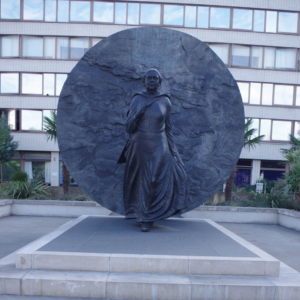 Sculpted by Martin Jennings and unveiled in 2016, the statue depicts the Jamaican-British businesswoman and herbal doctress striding forth in front of an impression of the Crimea where her British Hotel was based.
Sculpted by Martin Jennings and unveiled in 2016, the statue depicts the Jamaican-British businesswoman and herbal doctress striding forth in front of an impression of the Crimea where her British Hotel was based.
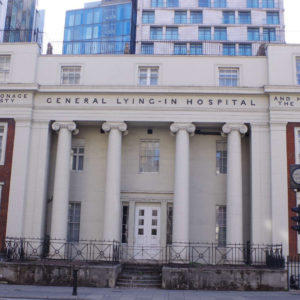 Founded in 1767 by Dr John Leake, the Lying-In Hospital provided midwifery and ante-natal care. Death in childbirth was a constant and very real threat at the time. With the establishment of the NHS in 1948, the hospital came under the management of St Thomas’ Hospital and finally closed in 1971.
Founded in 1767 by Dr John Leake, the Lying-In Hospital provided midwifery and ante-natal care. Death in childbirth was a constant and very real threat at the time. With the establishment of the NHS in 1948, the hospital came under the management of St Thomas’ Hospital and finally closed in 1971.
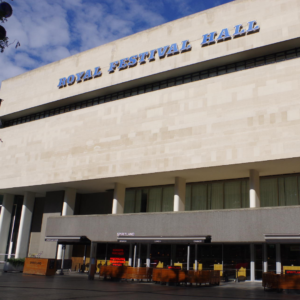 This is the only building that remains from the 1951 Festival of Britain, which had 22 themed pavilions and 13 restaurants and attracted 8.5 million paying visitors. One of those pavilions was the Health Pavilion, which showcased British work in medicine, surgery, public health and nursing. It celebrated the achievements of surgeons and doctors, particularly in medical research. The role of nurses was also celebrated, essential in the successful cure and rehabilitation of the sick.
This is the only building that remains from the 1951 Festival of Britain, which had 22 themed pavilions and 13 restaurants and attracted 8.5 million paying visitors. One of those pavilions was the Health Pavilion, which showcased British work in medicine, surgery, public health and nursing. It celebrated the achievements of surgeons and doctors, particularly in medical research. The role of nurses was also celebrated, essential in the successful cure and rehabilitation of the sick.
Wellbeing Tip
Prevention rather than cure meant that new exercise regimes also featured. Aimed at the housewife, these included Calisthenics and Hula Hooping. Weight loss tips of the time included eat more whole foods, eat at the table, eat smaller portions, drive less often and clean the house more! These are all still relevant today, with ‘daily activity’ including gardening, cleaning and other household chores assisting in keeping us fit and healthy.
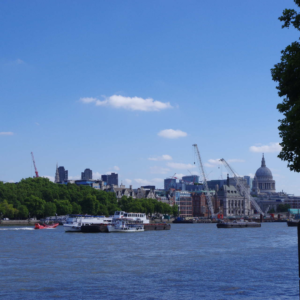 Back in 1858, the Great Stink was when the Thames was so heavily polluted that Londoners were dying in their thousands of cholera. Commissioner of Works, Joseph Bazalgette, cleaned up the river by creating London’s sewer system. The southern intercepting sewer lies just below your feet under the South Bank. Today the new Tideway Tunnel super sewer is under construction below the river to enhance the Victorian system. It is due to complete in 2025.
Back in 1858, the Great Stink was when the Thames was so heavily polluted that Londoners were dying in their thousands of cholera. Commissioner of Works, Joseph Bazalgette, cleaned up the river by creating London’s sewer system. The southern intercepting sewer lies just below your feet under the South Bank. Today the new Tideway Tunnel super sewer is under construction below the river to enhance the Victorian system. It is due to complete in 2025.
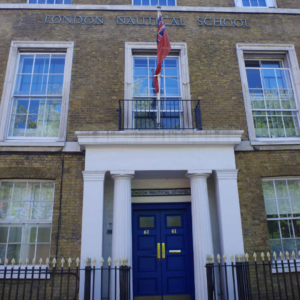 Established in 1915 to improve the skills of future merchant sailors, the school prepared boys for apprenticeships in the shipping industry. The school was probably founded in response to the sinking of the Titanic in 1912. Historically, sailors suffered from all sorts of work-related issues and illnesses. Scurvy, caused by a lack of vitamin C in their diet, was common. Many sailors also suffered from seasickness.
Established in 1915 to improve the skills of future merchant sailors, the school prepared boys for apprenticeships in the shipping industry. The school was probably founded in response to the sinking of the Titanic in 1912. Historically, sailors suffered from all sorts of work-related issues and illnesses. Scurvy, caused by a lack of vitamin C in their diet, was common. Many sailors also suffered from seasickness.
Wellbeing Tip
Ensure you get your 5 portions of fruit and veg a day. A morning glass of fruit juice or a smoothie is a great start, or a glass of weak lemon water to help rehydrate. You can find out more with the Public Health England Eatwell Guide.
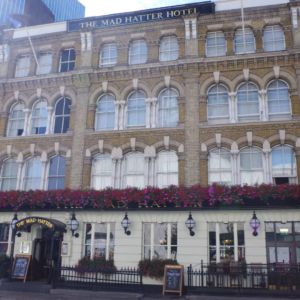 Named for the hat industry that was prevalent in this area in the 19th century, the pub name is more widely associated with Lewis Carroll’s Mad Hatter in “Alice in Wonderland”. Milliners used mercury solutions in their production process and mercury poisoning became widespread, causing excessive drooling, mood swings, distorted vision, confused speech, severe twitching, hallucinations, and dementia.
Named for the hat industry that was prevalent in this area in the 19th century, the pub name is more widely associated with Lewis Carroll’s Mad Hatter in “Alice in Wonderland”. Milliners used mercury solutions in their production process and mercury poisoning became widespread, causing excessive drooling, mood swings, distorted vision, confused speech, severe twitching, hallucinations, and dementia.
Wellbeing Tip
Some health studies suggest there may be health benefits to drinking wine and beer in moderation but keeping hydrated through drinking water and other non-alcoholic/non caffeinated drinks are still key to proper liver and kidney function and to help eliminate toxins that build up in the blood.
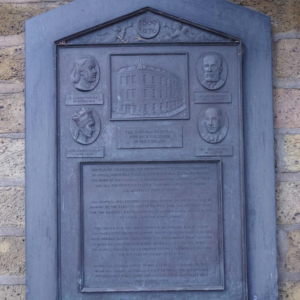 This used to be the site of the Evelina Hospital for Sick Children, which opened in 1869. Funded by Baron Ferdinand de Rothschild, it was built in memory of his wife, Evelina, who had died in childbirth along with their premature son. The hospital merged with Guy’s Hospital at London Bridge and then moved again in 2005 to an award-winning building at St Thomas’ Hospital. The Evelina Hospital plaque can be found on the wall near the corner of Southwark Bridge Road and Quilp Street.
This used to be the site of the Evelina Hospital for Sick Children, which opened in 1869. Funded by Baron Ferdinand de Rothschild, it was built in memory of his wife, Evelina, who had died in childbirth along with their premature son. The hospital merged with Guy’s Hospital at London Bridge and then moved again in 2005 to an award-winning building at St Thomas’ Hospital. The Evelina Hospital plaque can be found on the wall near the corner of Southwark Bridge Road and Quilp Street.
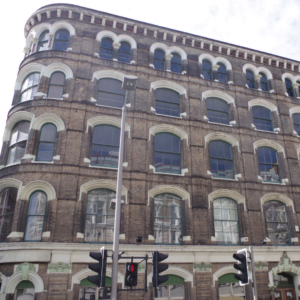 In the 1870s, this was the UK factory of the French Menier Chocolate Company, who originally marketed chocolate as a medicinal product. Its main usage was as a medicinal powder and for coating bitter-tasting pills.
In the 1870s, this was the UK factory of the French Menier Chocolate Company, who originally marketed chocolate as a medicinal product. Its main usage was as a medicinal powder and for coating bitter-tasting pills.
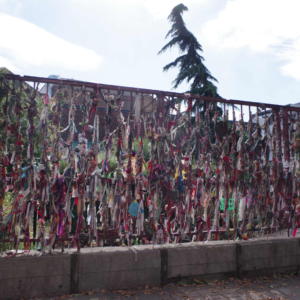 Discovered during the construction of the Jubilee Line in the 1990s, this was a pauper’s cemetery. Many of the single women buried here were prostitutes who were denied burial in consecrated ground. The Friends of Cross Bones created a permanent memorial garden to remember those unfortunate women.
Discovered during the construction of the Jubilee Line in the 1990s, this was a pauper’s cemetery. Many of the single women buried here were prostitutes who were denied burial in consecrated ground. The Friends of Cross Bones created a permanent memorial garden to remember those unfortunate women.
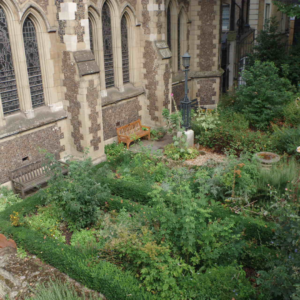 Originally a 12th century Augustinian Priory, the clergy founded a medieval hospital on the south side of the church and dedicated it to the martyred Archbishop of Canterbury, Thomas Becket. The churchyard contains a recreation of the medieval monastic herb garden. There are over 50 different kinds of herbs and plants used for cooking and treating the sick. When the cathedral is closed, the herb garden can be viewed from the street above as you approach London Bridge.
Originally a 12th century Augustinian Priory, the clergy founded a medieval hospital on the south side of the church and dedicated it to the martyred Archbishop of Canterbury, Thomas Becket. The churchyard contains a recreation of the medieval monastic herb garden. There are over 50 different kinds of herbs and plants used for cooking and treating the sick. When the cathedral is closed, the herb garden can be viewed from the street above as you approach London Bridge.
Wellbeing Tip
Try growing your own herbs at home. Lavendar is good for relaxation and sleep and many herbs can be used in teas, to reduce down on caffeine in drinks like tea and coffee – a few cups a day is fine but try and avoid as your last cup of the day!
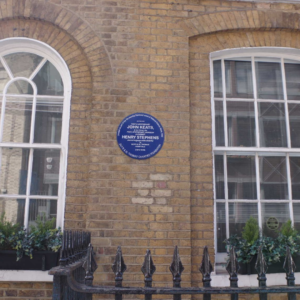 This plaque commemorates Romantic poet, John Keats, who began an earlier career in medicine and leased rooms here. After completing an apprenticeship in pharmacy and surgery, Keats registered as a student at Guy’s Hospital and received his medical license in 1816.
This plaque commemorates Romantic poet, John Keats, who began an earlier career in medicine and leased rooms here. After completing an apprenticeship in pharmacy and surgery, Keats registered as a student at Guy’s Hospital and received his medical license in 1816.
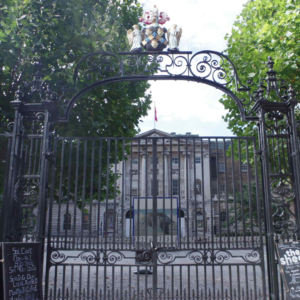 Named for Thomas Guy, who was a governor of St Thomas’ Hospital in the early 1700s and left £219,499 in his will for a new hospital. Today Guy’s Hospital is one of the UK’s leading teaching hospitals with a pioneering Cancer Centre. Both the chapel and the statue of John Keats in the garden are worth a visit.
Named for Thomas Guy, who was a governor of St Thomas’ Hospital in the early 1700s and left £219,499 in his will for a new hospital. Today Guy’s Hospital is one of the UK’s leading teaching hospitals with a pioneering Cancer Centre. Both the chapel and the statue of John Keats in the garden are worth a visit.
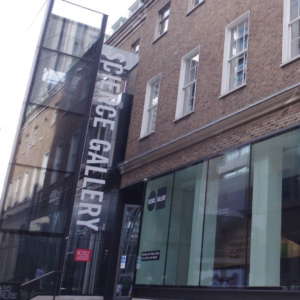 The Science Gallery is a collaboration between the Science Museum, King’s College London and local communities and artists. It presents exhibitions, conducts live experiments, and showcases events and performances.
The Science Gallery is a collaboration between the Science Museum, King’s College London and local communities and artists. It presents exhibitions, conducts live experiments, and showcases events and performances.
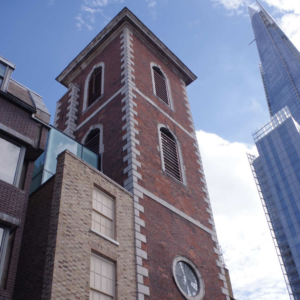 Originally the chapel of the medieval St Thomas’ Hospital, the church is the oldest surviving part of the hospital in Southwark. In the 18th century, the attic was used as an herb garret. In the 19th century, the herb garret was turned into an operating theatre for the women’s ward. Florence Nightingale started the world’s first secular, professional School of Nursing in the old St Thomas’ Hospital in 1860. Today, this atmospheric museum offers a unique insight into the history of medicine and surgery.
Originally the chapel of the medieval St Thomas’ Hospital, the church is the oldest surviving part of the hospital in Southwark. In the 18th century, the attic was used as an herb garret. In the 19th century, the herb garret was turned into an operating theatre for the women’s ward. Florence Nightingale started the world’s first secular, professional School of Nursing in the old St Thomas’ Hospital in 1860. Today, this atmospheric museum offers a unique insight into the history of medicine and surgery.
 Celebrating the life and work of the best-known figure in British nursing history, Florence Nightingale, the museum showcases her life, time in the Crimean War, statistical work and work on health reforms. Items on display include the famous lamp she carried in Crimean War, her personal medicine chest, copies of her statistical charts and her pet owl, Athena.
Celebrating the life and work of the best-known figure in British nursing history, Florence Nightingale, the museum showcases her life, time in the Crimean War, statistical work and work on health reforms. Items on display include the famous lamp she carried in Crimean War, her personal medicine chest, copies of her statistical charts and her pet owl, Athena.
 Founded in the 12th century, the hospital was originally based near London Bridge and moved here in 1871. Inside is a small exhibition on the history of St Thomas’ Hospital and a statue of Florence Nightingale. The hospital chapel has a bust of Florence Nightingale and a memorial to Sarah Wardroper, the first Superintendent of the Nightingale Training School for Nurses. In the grounds by the river is the Florence Nightingale Garden, which was created to celebrate the bicentenary of her birth.
Founded in the 12th century, the hospital was originally based near London Bridge and moved here in 1871. Inside is a small exhibition on the history of St Thomas’ Hospital and a statue of Florence Nightingale. The hospital chapel has a bust of Florence Nightingale and a memorial to Sarah Wardroper, the first Superintendent of the Nightingale Training School for Nurses. In the grounds by the river is the Florence Nightingale Garden, which was created to celebrate the bicentenary of her birth.
 Sculpted by Martin Jennings and unveiled in 2016, the statue depicts the Jamaican-British businesswoman and herbal doctress striding forth in front of an impression of the Crimea where her British Hotel was based.
Sculpted by Martin Jennings and unveiled in 2016, the statue depicts the Jamaican-British businesswoman and herbal doctress striding forth in front of an impression of the Crimea where her British Hotel was based.
 Founded in 1767 by Dr John Leake, the Lying-In Hospital provided midwifery and ante-natal care. Death in childbirth was a constant and very real threat at the time. With the establishment of the NHS in 1948, the hospital came under the management of St Thomas’ Hospital and finally closed in 1971.
Founded in 1767 by Dr John Leake, the Lying-In Hospital provided midwifery and ante-natal care. Death in childbirth was a constant and very real threat at the time. With the establishment of the NHS in 1948, the hospital came under the management of St Thomas’ Hospital and finally closed in 1971.
 This is the only building that remains from the 1951 Festival of Britain, which had 22 themed pavilions and 13 restaurants and attracted 8.5 million paying visitors.
This is the only building that remains from the 1951 Festival of Britain, which had 22 themed pavilions and 13 restaurants and attracted 8.5 million paying visitors.
One of those pavilions was the Health Pavilion, which showcased British work in medicine, surgery, public health and nursing. It celebrated the achievements of surgeons and doctors, particularly in medical research. The role of nurses was also celebrated, essential in the successful cure and rehabilitation of the sick.
Wellbeing Tip
Prevention rather than cure meant that new exercise regimes also featured. Aimed at the housewife, these included Calisthenics and Hula Hooping. Weight loss tips of the time included eat more whole foods, eat at the table, eat smaller portions, drive less often and clean the house more! These are all still relevant today, with ‘daily activity’ including gardening, cleaning and other household chores assisting in keeping us fit and healthy.
 Back in 1858, the Great Stink was when the Thames was so heavily polluted that Londoners were dying in their thousands of cholera. Commissioner of Works, Joseph Bazalgette, cleaned up the river by creating London’s sewer system. The southern intercepting sewer lies just below your feet under the South Bank. Today the new Tideway Tunnel super sewer is under construction below the river to enhance the Victorian system. It is due to complete in 2025.
Back in 1858, the Great Stink was when the Thames was so heavily polluted that Londoners were dying in their thousands of cholera. Commissioner of Works, Joseph Bazalgette, cleaned up the river by creating London’s sewer system. The southern intercepting sewer lies just below your feet under the South Bank. Today the new Tideway Tunnel super sewer is under construction below the river to enhance the Victorian system. It is due to complete in 2025.
 Established in 1915 to improve the skills of future merchant sailors, the school prepared boys for apprenticeships in the shipping industry. The school was probably founded in response to the sinking of the Titanic in 1912. Historically, sailors suffered from all sorts of work-related issues and illnesses. Scurvy, caused by a lack of vitamin C in their diet, was common. Many sailors also suffered from seasickness.
Established in 1915 to improve the skills of future merchant sailors, the school prepared boys for apprenticeships in the shipping industry. The school was probably founded in response to the sinking of the Titanic in 1912. Historically, sailors suffered from all sorts of work-related issues and illnesses. Scurvy, caused by a lack of vitamin C in their diet, was common. Many sailors also suffered from seasickness.
Wellbeing Tip
Ensure you get your 5 portions of fruit and veg a day. A morning glass of fruit juice or a smoothie is a great start, or a glass of weak lemon water to help rehydrate. You can find out more with the Public Health England Eatwell Guide.
 Named for the hat industry that was prevalent in this area in the 19th century, the pub name is more widely associated with Lewis Carroll’s Mad Hatter in “Alice in Wonderland”. Milliners used mercury solutions in their production process and mercury poisoning became widespread, causing excessive drooling, mood swings, distorted vision, confused speech, severe twitching, hallucinations, and dementia.
Named for the hat industry that was prevalent in this area in the 19th century, the pub name is more widely associated with Lewis Carroll’s Mad Hatter in “Alice in Wonderland”. Milliners used mercury solutions in their production process and mercury poisoning became widespread, causing excessive drooling, mood swings, distorted vision, confused speech, severe twitching, hallucinations, and dementia.
Wellbeing Tip
Some health studies suggest there may be health benefits to drinking wine and beer in moderation but keeping hydrated through drinking water and other non-alcoholic/non caffeinated drinks are still key to proper liver and kidney function and to help eliminate toxins that build up in the blood.
 This used to be the site of the Evelina Hospital for Sick Children, which opened in 1869. Funded by Baron Ferdinand de Rothschild, it was built in memory of his wife, Evelina, who had died in childbirth along with their premature son. The hospital merged with Guy’s Hospital at London Bridge and then moved again in 2005 to an award-winning building at St Thomas’ Hospital. The Evelina Hospital plaque can be found on the wall near the corner of Southwark Bridge Road and Quilp Street.
This used to be the site of the Evelina Hospital for Sick Children, which opened in 1869. Funded by Baron Ferdinand de Rothschild, it was built in memory of his wife, Evelina, who had died in childbirth along with their premature son. The hospital merged with Guy’s Hospital at London Bridge and then moved again in 2005 to an award-winning building at St Thomas’ Hospital. The Evelina Hospital plaque can be found on the wall near the corner of Southwark Bridge Road and Quilp Street.
 In the 1870s, this was the UK factory of the French Menier Chocolate Company, who originally marketed chocolate as a medicinal product. Its main usage was as a medicinal powder and for coating bitter-tasting pills.
In the 1870s, this was the UK factory of the French Menier Chocolate Company, who originally marketed chocolate as a medicinal product. Its main usage was as a medicinal powder and for coating bitter-tasting pills.
 Discovered during the construction of the Jubilee Line in the 1990s, this was a pauper’s cemetery. Many of the single women buried here were prostitutes who were denied burial in consecrated ground. The Friends of Cross Bones created a permanent memorial garden to remember those unfortunate women.
Discovered during the construction of the Jubilee Line in the 1990s, this was a pauper’s cemetery. Many of the single women buried here were prostitutes who were denied burial in consecrated ground. The Friends of Cross Bones created a permanent memorial garden to remember those unfortunate women.
 Originally a 12th century Augustinian Priory, the clergy founded a medieval hospital on the south side of the church and dedicated it to the martyred Archbishop of Canterbury, Thomas Becket. The churchyard contains a recreation of the medieval monastic herb garden. There are over 50 different kinds of herbs and plants used for cooking and treating the sick. When the cathedral is closed, the herb garden can be viewed from the street above as you approach London Bridge.
Originally a 12th century Augustinian Priory, the clergy founded a medieval hospital on the south side of the church and dedicated it to the martyred Archbishop of Canterbury, Thomas Becket. The churchyard contains a recreation of the medieval monastic herb garden. There are over 50 different kinds of herbs and plants used for cooking and treating the sick. When the cathedral is closed, the herb garden can be viewed from the street above as you approach London Bridge.
Wellbeing Tip
Try growing your own herbs at home. Lavendar is good for relaxation and sleep and many herbs can be used in teas, to reduce down on caffeine in drinks like tea and coffee – a few cups a day is fine but try and avoid as your last cup of the day!
 This plaque commemorates Romantic poet, John Keats, who began an earlier career in medicine and leased rooms here. After completing an apprenticeship in pharmacy and surgery, Keats registered as a student at Guy’s Hospital and received his medical license in 1816.
This plaque commemorates Romantic poet, John Keats, who began an earlier career in medicine and leased rooms here. After completing an apprenticeship in pharmacy and surgery, Keats registered as a student at Guy’s Hospital and received his medical license in 1816.
 Named for Thomas Guy, who was a governor of St Thomas’ Hospital in the early 1700s and left £219,499 in his will for a new hospital. Today Guy’s Hospital is one of the UK’s leading teaching hospitals with a pioneering Cancer Centre. Both the chapel and the statue of John Keats in the garden are worth a visit.
Named for Thomas Guy, who was a governor of St Thomas’ Hospital in the early 1700s and left £219,499 in his will for a new hospital. Today Guy’s Hospital is one of the UK’s leading teaching hospitals with a pioneering Cancer Centre. Both the chapel and the statue of John Keats in the garden are worth a visit.
 The Science Gallery is a collaboration between the Science Museum, King’s College London and local communities and artists. It presents exhibitions, conducts live experiments, and showcases events and performances.
The Science Gallery is a collaboration between the Science Museum, King’s College London and local communities and artists. It presents exhibitions, conducts live experiments, and showcases events and performances.
 Originally the chapel of the medieval St Thomas’ Hospital, the church is the oldest surviving part of the hospital in Southwark. In the 18th century, the attic was used as an herb garret. In the 19th century, the herb garret was turned into an operating theatre for the women’s ward. Florence Nightingale started the world’s first secular, professional School of Nursing in the old St Thomas’ Hospital in 1860. Today, this atmospheric museum offers a unique insight into the history of medicine and surgery.
Originally the chapel of the medieval St Thomas’ Hospital, the church is the oldest surviving part of the hospital in Southwark. In the 18th century, the attic was used as an herb garret. In the 19th century, the herb garret was turned into an operating theatre for the women’s ward. Florence Nightingale started the world’s first secular, professional School of Nursing in the old St Thomas’ Hospital in 1860. Today, this atmospheric museum offers a unique insight into the history of medicine and surgery.
Health and Wellness Tips
Focusing on the ‘5 Ways to Wellbeing’ – Connect, Be Active, Take Notice, Learn, Give – this walk has been designed to keep both the mind and body healthy. While undertaking the walk and learning about the area take notice of the sights, sounds and smells around you. Take a moment to breathe and practice mindfulness by the waters of the Thames or surrounded by plants in a herb garden. Enjoy the exercise and make the most of the walk.
Tips for the Walk
- Wear comfortable, supportive footwear.
- Wear layers you can easily remove or put on. You can carry a poncho or pack-up mac if you don’t want to carry a coat.
- If you’re taking a bag, try a backpack and adjust it correctly so it doesn’t pull on your back or shoulders.
- Use the toilet and drink plenty of water to stay hydrated.
- Take a few timeouts to breathe and rehydrate. If you are in a group, be open and honest about how quickly you can walk and when you need to take a break and rest.
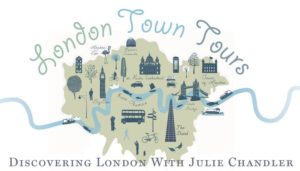
This walk can be offered as a guided tour with professional Blue Badge Guide Julie Chandler. Get a group together and book with London Town Tours to discover even more about this interesting part of London’s history. Julie leads walks on a wide range of subjects and introduces visitors to London’s wonderful and exciting heritage.
This walk is part of the London Bridge Medi-Culture Programming and involves the work of Team London Bridge, Florence Nightingale Museum, The Old Operating Theatre, and London Town Tours.

